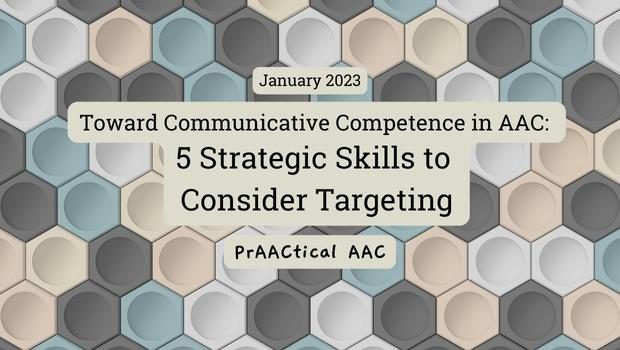Toward Communicative Competence in AAC: 5 Strategic Skills to Consider Targeting

Communicative competence is a multi-faceted concept that was introduced to the AAC field by Dr. Janice Light over 3 decades ago. One area that is sometimes neglected is strategic competence. In this post, we offer suggestions for compensatory skills to target to improve the effectiveness and efficiency of AAC-mediated interactions.
- Attention-getting: While most AAC users get the attention of their communication partners before sharing their thoughts and messages, beginning communicators may need explicit instruction in this area. It is particularly important for those who use AAC tools that have no voice output, such as a no-tech eye gaze frame or a core communication board. This is also an important skill to teach to those who rely on a partner’s assistance to create messages, such as PODD book users.
- Modality switching: Ben is an effective keyword signer who prefers this modality over all others. This works well with others who sign and know Ben’s unique versions of the signs. However, that excludes many potential communication partners. Some people are quick to recognize that signing doesn’t work with everyone and automatically switch to a different mode of communication. Others, though, need help in learning to do this. Explicit instruction to help people know which communication mode to use in various situations can go a long way in building successful interactions.
- Word prediction: Efficiency is important in communicating with AAC. Word prediction saves keystrokes and can speed up communication for some AAC users. Many people who use AAC require no instruction, but there are others who need explicit teaching in order to use it effectively. We wrote about strategies for teaching word prediction in a previous post that you may find helpful.
- Comprehension checks: Like many AAC users, Marc had a lot to say. He would invariably create long messages with his text-to-speech device. Due to numerous spelling errors and lack of spaces between words, though, his messages were often indecipherable. Ella, who uses a picture-based AAC device, would often launch a conversation without enough information about the topic. She generally starts in the middle when she tells stories about her experiences, which makes it even more challenging for communication partners to understand what Ella is trying to say. For some AAC communicators, it is helpful to provide clear information on checking their partner’s comprehension before proceeding. Helping them to recognize when communication breakdowns are likely to occur, and using strategies to prevent or resolve them can contribute to more successful interactions. Teaching them about topic-setting and using prestored messages for comprehension checks (e.g., “Did you get that?” “Do you understand what I mean?”) can be highly beneficial.
- Partner instructions: Another thing that can help build success in AAC conversations relates to communicating with less familiar partners. Working with AAC users to pre-program specific instructions (E.g., “Stand in front of me where I can see you.” “Wait for me to finish.” “Don’t ask two questions at the same time.”) can be an important area to target.
Do you have ideas for skills to teach in building strategic competence? We’d love to hear about them.
Filed under: PrAACtical Thinking
This post was written by Carole Zangari
